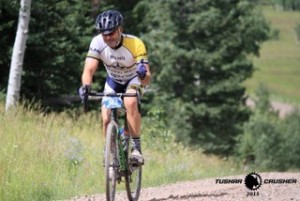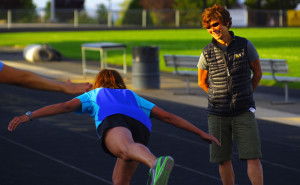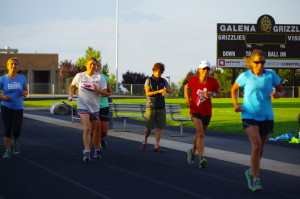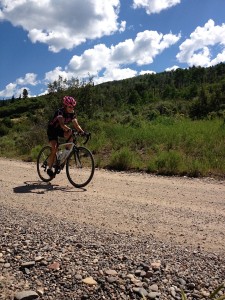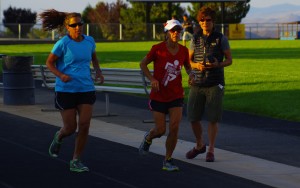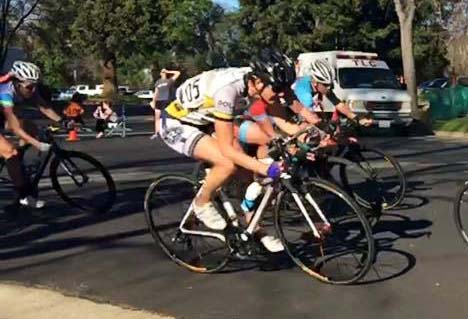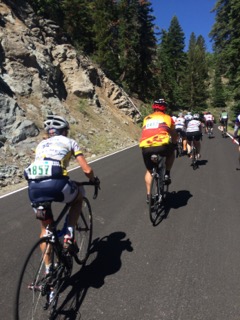This year, I joined two of my longtime athletes, and good friends, Sian and Andy at the Leadville 100-mile Mountain Bike Race. My Leadville-rasion d’etre was not in pursuit of individual results but rather a fully focused commitment to ride alongside, pace and support Sian and Andy. The goal – completing the 100-plus miles in sub-nine hours and the belt buckle that goes with it. It was an amazing experience, rich with many learning opportunities along the way. A concise recap, with reflections and take-aways of our Leadville adventure, from my eyes, follows…

Leadville Prep
Over the past year, Andy and Sian had consistently committed to a structured, training plan to prepare for Leadville. As a result they each made leaps and bounds in their cycling specific strength and performance, tactical skills and ability to mentally and physically endure endurance. During the training year we also capitalized on the opportunity to optimize metabolic efficiency, a key in ultra-endurance events, by phasing appropriate nutrition with appropriate training.
Effective training for Leadville is not based on slogging through more and more mindless endurance miles, but rather developing and improving sport specific strength, power, muscular endurance and pedaling efficiency. Training is equally important for the mental conditioning it affords to tackle the mental demands of the event. So our training included workouts that demanded full mental and physical engagement, including weekly intervals, race rides and shorter XC races. We then punctuated these quality intensity days with simulated Leadville long endurance rides on dirt roads which included sky-high elevation gains.

As a dress rehearsal for pacing at Leadville, I paced Andy at the Tahoe Trails 100, which was a valuable learning experience on the importance of racer to pacer communication.
The Game Plan
Pre-Leadville, the three of us had met on several occasions to discuss and fine tune our race day, game-plan – how we would race each distinct section of Leadville, and how I could best support their efforts. In this process, I realized success at Leadville demanded a strategic approach. It was also a time to consider contingency plans in the case of flats, mechanicals, etc. We also discussed the course of action in the case that either Andy or Sian might not being having a great day. Do we all three stay together no matter what, or does one carry on to go after the coveted sub-nine hour time?

Another aspect of these ultra-events, which we were all well aware, are the highs and lows, we typically experience. (As a side note to this race recap, it seems this aspect is actually one of the allures of endurance events – challenging us to pull, or in this case, pedal ourselves mentally through the rough patches. As a result, we derive a deep sense of empowerment and confidence which carries in to every walk of our life.)
We also realized significant time could be gained or lost at the aid stations – so equipped with an amazingly supportive crew, we knew that “grab and go,” would be our motto.
A game plan was a necessity, for sure, and we were thorough in dissecting what we foresaw as every possible scenario. But racing is racing, and in most cases, things go side-ways, so that’s when the game-plan goes bye-bye, and nimble decision making kicks in. (Side note #2…this is again is one of those valuable lasting mental take-aways of physical racing, we throw ourselves in to these uncontrolled, challenging situations and learn, we can deal with it.)
The Rifle Goes Off
Race day delivered unusually warm temps and clear skies. We were fortunate to have an extensive, supportive crew – I think the ratio was at least two to three crew (if you count my dog Lucky), to one racer. We knew with our crew on hand, our aid station stops would be efficient. It was also reassuring to know those who genuinely cared for us, were standing by.

Our race start went exactly according to plan, zipping down the still-sort-of-dark, Leadville streets, with 2,000 of our new best friends. We then funneled on to the dirt road, leading to the first, steep, pithcy climb, St. Kevins. It seemed a blistering start for a 103-miler. Once on the other side of St. Kevins we settled in to our rhythm as a three-person team. I set the pace up the climb to SugarLoaf depending on Sian and Andy’s communication to dictate the pace.

The top of SugarLoaf led to the infamous Powerline descent. Andy is a Leadville Vet and had spent two weeks leading up to the race reconning the course, not to mention he naturally flies down descents – so we put Andy on the front to find the lines and lead us down. There were, for sure, some crazies on the way down, chomping on our tires from behind, trying to find a non-existent line to gain maybe 10, stupid- seconds. But the key was blocking them out, staying calm, relaxed and composed to focus forward, and not allowing them to pressure or intimidate. We dumped off Powerline, successfully – and regrouped to head across the flats, one of the most pivotal sections of the Leadville course.

Entering in to Leadville – I think most racers fixate on those parts of the course, the Powerline and Columbine climbs that have been sensationalized by the movies. But truly the place to make time, is getting in to a strong pace-lining group across the flats (relative – false flats, rolling, etc) between the bottom of Powerline and the bottom of Columbine.
Off Powerline, we found ourselves in a strong rotating pace-line of about 10-12 racers. We were cruising across a paved road at about 25mph, our race game plan was right on target. Then quickly and violently things changed – there was the terrible, unforgettable noise of metal screeching across pavement resulting in the traumatic scene of two guys and two bikes, strewn across the road, immediately in front of me. It seemed time stood still, I still see the scene vividly in my mind. But because it almost seemed in slow motion, I was able to somewhat devise a lesser-of-two-evils exit strategy, managing to lift my front wheel over the carnage, sparing the perfect broken collar-bone scenario. But my bunny hop skills still need work, and I was not able to completely clear it, getting bucked to the left and taking a hard hit on my left side head, elbow and hip.
In the ensuing chaos – I shewed Sian (who had hit the deck softly, landing on some others in the pile) and Andy on their way. I had thought my day was done. But I collected myself and started pedaling, I had to get to the Twin Lakes aid station, somehow, anyway. As I pedaled, I started catching and drafting others, and before I knew it, I was back up with Sian and Andy. I figured, I would give as much as I could, ride as hard as I could, as long as I could to help them. So from that point it was section by section for me.

This crash definitely threw a wrench in our race game plan. It was traumatic and as a result it understandably shirked Sian’s confidence to find and hold a wheel. But this is part of racing, so we mentally regrouped and forged forward.
What I realized over the remaining sections of the race was that having a single pacer for two racers in an event of this nature, was not effective. As I noted above, in these events we all typically have fairly defined highs and lows. During the remaining part of Leadville – Sian and Andy were unfortunately on opposite schedules of experiencing those highs and lows – each having strong sections, and challenging ones at nearly opposite times. In hindsight, in our attempt to stay cohesive as a team of three, I think they both seemed to have missed opportunities that would have improved their final times.

In reflection, it does seem the truly pivotal sections of Leadville, in terms of putting down good times, are on those flats, outbound and inbound, between Powerline and Columbine. I think too, it is that willingness, every so often in these ultra-endurance events, to push yourself that little bit more, outside the endurance comfort zone to, for example, bridge up to a wheel to get the free, easy, energy-conserving ride on the train.

I am so proud of both Sian and Andy – they battled all day, exhibited the mental and physical strength derived from their commitment to year-long, consistent, purposeful training. At the end of the day – Sian and Andy left it all mentally and physically on the Leadville dirt. They overcame and ran toward rather than away from doubts and fears, and pedaled themselves through the rough patches. This is a prize far more enduring and powerful than any belt buckle.
And with all the adversity both Sian and Andy confronted, tackled and overcame, they both improved their past PRs by over 15min – a monumental achievement in this one-of-a-kind epic event.

